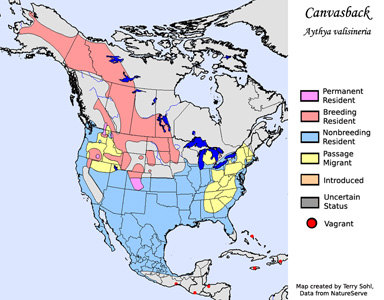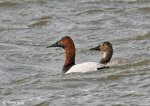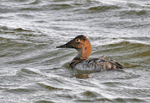| Length: 19 to 23 inches | Wingspan: 28 to 36 inches | Seasonality: Summer / Migrant |
| ID Keys: Chestnut head, black chest, black bill, white back. Compare to Redhead. | ||
 Canvasbacks
are the biggest of the diving ducks found in the state. They are
generally more wary and less tolerant of human presence than some of the
other ducks. Numbers are far below historical levels, probably due to
losses of wetland habitat essential for breeding success.
Canvasbacks
are the biggest of the diving ducks found in the state. They are
generally more wary and less tolerant of human presence than some of the
other ducks. Numbers are far below historical levels, probably due to
losses of wetland habitat essential for breeding success.
Habitat: Marshes, sloughs, shallow lakes and ponds with emergent vegetation along the edges.
Diet: Mostly the leaves, roots, and seeds of aquatic plants, also some insects, crustaceans, and small fish.
Behavior: Primarily forages in water a few feet deep, diving underwater for food. They also sometimes feed at the surface, either grabbing food items from the water's surface, or tipping down and submerging their head underwater.
Nesting: May through July. The nest of a Canvasback is a basket of reeds and other dead vegetations, placed in dense wetland vegetation or on nearby shoreline. The female usually lays between 8 and 11 eggs, and she alone incubates them. The young leave the nest within a few hours of hatching, and find their own food. The female stays with the young and protects them. The young fledge after about 9 weeks.
Song: Croaks or grunts.
Migration: Summers in the western U.S., northern Great Plains, Alaska, and western Canada. Winters in the southern U.S., near the U.S. coasts, and Mexico.
Interactive eBird Map: Click to access an interactive map of Canvasback sightings
Similar Species: Redhead
Conservation Status: Has been in general decline the last several decades. However, they are still found over a wide geographic area, and overall populations are not currently felt to be threatened. The IUCN lists the Canvasback as a species of "Least Concern".
Further Information: 1) USGS Patuxent Bird Identification InfoCenter, Canvasback
Photo Information: March 30th, 2003 -- Western Minnehaha County -- Terry L. Sohl
Additional Photos: Click on the image chips or text links below for additional, higher-resolution Canvasback photos.
| Click on the range map for a higher-resolution view |
 |
| South Dakota Status: Common migrant in the eastern part of the state, uncommon in the west. Common summer breeding resident in the northeast, uncommon to rare elsewhere. Rare in winter in areas with open water. |
Additional Canvasback Photos
Click for a higher-resolution version of these photos



